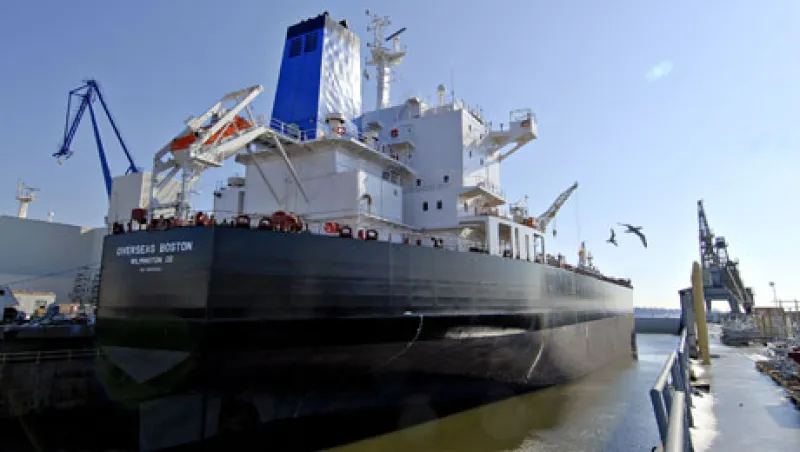Shipbuilding is typically a boom-bust business. Thanks in large part to the surge in U.S. energy production, especially from shale, American shipbuilders are entering the positive side of the cycle — with investors riding the wave.
The trend hasn’t gone unnoticed by institutional investors. The Alaska Permanent Fund, a state-level sovereign wealth fund that invests Alaska’s mineral lease royalties, recently took a position in Aker ASA, the Norwegian parent company of one of the two main U.S. builders of petroleum tankers, Aker Philadelphia Shipyard. There are 32 of these tankers presently in use by U.S. shippers; in the past 12 months, eight have been diverted from other uses to move crude oil within the Gulf of Mexico.
Aker and its peer, San Diego–based General Dynamics Nassco, are both full up on orders to 2016, according to the prospectus for American Petroleum Tankers (APT), a new ship owner and contractor with equity interests held by affiliates of New York–based Blackstone Group and Cerberus Capital Management. Companies such as APT and Kirby Corp., which owns a fleet of smaller-transport inland barges, are enjoying steep rises in rates to lease out their vessels — from $50,000 a day in the spot market to $80,000.
“We’re getting to the point where pricing is going to take off,” said Kenneth Hoexter, a transportation equity research analyst for Bank of America Merrill Lynch.
With more ships needed and owning them increasingly profitable, fleet owners stand to benefit as well. Kirby operates barges and has seen institutional purchases in the third quarter from pension funds such as the Municipal Employees’ Retirement System of Michigan and the New York State Common Retirement Fund. Investors are also looking for other ways to get exposure to the domestic shipping industry, because there are few U.S. equities that provide it. One such example is General Dynamics Nassco’s parent, the publicly traded General Dynamics. But auxiliary and commercial ships account for a scant 2.4 percent of the Falls Church, Virginia–based aerospace and defense company’s revenue. This trend suggests that institutions are investing directly and providing credit. Aker Philadelphia Shipyard announced a secured term loan of $65 million in November from Santa Monica, California–based Tennenbaum Capital Partners, which has also invested in a smaller shipyard, TY Offshore. With regards to oil refining, Blackstone has also purchased a shuttered refinery in Delaware, and Washington, D.C.–based private equity firm Carlyle Group bought a majority stake in the Philadelphia Refinery, which had been under threat of closure. Refiners on the U.S. East Coast hope they can restore sustainable profit margins by using domestic crude rather than more expensive imports.
Shale extraction is driving the growth in shipbuilding. Producers expect a glut of oil to come from the U.S. interior in the coming years, and the existing U.S. pipeline network is insufficient to move crude from such oil plays as the Eagle Ford in Texas and the Bakken deposits in North Dakota and Montana to downstream users. Although demand in the next two decades is subject to a range of projections that seems too wide for major investment decisions just yet, the trend is already a positive for the shipping industry across all modes of transportation.
“Crude oil transport operators are an interesting and attractive way to play shale because they generally don’t have direct exposure to commodity prices,” says Jeremy Tonet, a research analyst for J.P. Morgan in New York. “They get the benefit of the increased volumes of production but not the downside if prices fall.”
Shipping rates in 2013 corroborate Tonet’s observation. Global rates for very large crude carriers, defined as ships with a capacity of at least 200,000 deadweight tonnage, were slumping during the first half of 2013, whereas costs to use U.S.-built ships in the domestic market were reaching new highs. ExxonMobil paid a lofty rate of $100,000 per day for a carrier in June. U.S.-built tankers are about $120 million, generally triple the price of ships built elsewhere. The costs of complying with U.S. labor laws also drive domestic shipping costs higher.
Railroads have emerged as another opportunity for transport investment, which could bring some attention to a group of equities many investors unwisely ignore. “The railroads have outperformed the S&P for 14 consecutive years, which still surprises investors,” BofA Merrill Lynch’s Hoexter says. “Crude oil, while still small, is a big growth area.” He rates as buys railroads Union Pacific and CSX, as well as shipbuilder Kirby.
Though shipping rates have fallen globally, institutional investors have been buying up shares of U.S.-based global shipping-and-logistics companies. According to data from Bloomberg, institutional ownership of suburban Minneapolis–headquartered C.H. Robinson Worldwide jumped 4.6 percent from mid-October to mid-November, to 37 percent of the company’s shares. Buyers include pension funds such as the California Public Employees’ Retirement System (CalPERS), the Ohio Public Employees Retirement System and Kentucky Retirement Systems.






